
The Slater Mill is a historic textile mill complex on the banks of the Blackstone River in Pawtucket, Rhode Island, modeled after cotton spinning mills first established in England. It is the first water-powered cotton spinning mill in North America to utilize the Arkwright system of cotton spinning as developed by Richard Arkwright.

Carolina is a village that straddles the border of the towns of Charlestown and Richmond on the Pawcatuck River in Washington County, Rhode Island. Rhode Island Route 112 passes through the village. Carolina is identified as a census-designated place, with a population of 970 at the 2010 census.

Allenville Mill Storehouse is a historic mill storehouse at 5 Esmond Street in Esmond, Rhode Island within the town of Smithfield, Rhode Island. The exact date of construction is unknown, but it was built with rubble masonry construction which was typical of mill construction during and after the War of 1812. In 1813, Phillip Allen purchased 4.5 acres of land and constructed a mill on the site, but the first record to specifically refer to the storehouse was an insurance policy from 1836. Allen sold the property in 1857 and it changed ownership several times before it became Esmond Mills in 1906. In 1937, the building was used as a post office and described erroneously as the "Old Allenville Mill". The building has had some alterations to the front door and possibly the addition of a side door, but the interior of the structure was not detailed in the National Register of Historic Places nomination. The Allenville Mill Storehouse was added to the National Register of Historic Places in 1972.
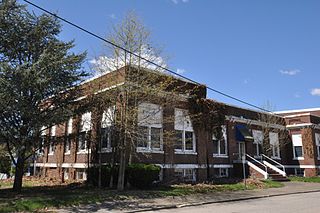
The Richmond Paper Company Mill Complex is an historic American paper mill at 310 Bourne Avenue in East Providence, Rhode Island. It consists of a collection of mainly brick buildings on 13 acres (5.3 ha) of land, bounded on the north by Bourne Avenue, the east by railroad tracks, the west by the Seekonk River, and on the south by land formerly owned by the Washburn Wire Company. The first seven of the surviving buildings were built between 1883 and 1887 by the Richmond Paper Company. The property was acquired at auction in 1894 by Eugene Phillips, who operated the American Electrical Works on the premises, adding further buildings between 1900 and 1930 and demolishing several buildings specific to paper processing. The property presently sees a variety of light industrial uses. The Richmond Paper Company is notable as the place where Arthur Dehon Little started his career.

The Perkins Buildings are a group of three historic industrial buildings located at 85 Sprague Street, 101 and 102 Westfield Street in Providence, Rhode Island. They were built between 1887 and 1892 by Charles H. Perkins, and were originally occupied by separate industrial tenants. Two of the buildings are brick structures built in 1892 and 1890, respectively, while the 1887 mill at 101 Westfield is a wood-frame structure, a rare 19th-century survivor in the state. These buildings were consolidated into a single industrial complex in the first half of the 20th century by the Rau Fastener Company, which operated on the premises until 1994.

The Church Hill Industrial District is an industrial historic district on the west side of Pawtucket, Rhode Island. It encompasses an area that was intensively developed between about 1850 and 1920, and includes five separate industrial facilities. Four of these are relatively modest in size, and originally served a combination of textile mills and ironworks, the latter of which often manufactured parts used in the textile manufacturing processes. The oldest building is an 1848 ironworks facility, which runs along Pine Street between Main and Bayley. The largest single complex, added in the 2011 expansion of the district, is the Union Waddell complex between Bayley Street and the Amtrak railroad tracks, which has ten surviving buildings from the early 20th century.

The Conant Thread—Coats & Clark Mill Complex District is a historic district encompassing a large industrial complex which straddles the border between Pawtucket and Central Falls, Rhode Island. This 50-acre (20 ha) industrial area was developed in two phases, with a number of buildings surviving from both of these periods. The first, between 1870 and 1882, resulted in the construction of Mills 2 through 5, a series of large three- and four-story brick buildings which were used in textile manufacturing. A brick office and stables from this period were demolished in 1977, and are the only known brick structures to have been lost. The second phase of construction was between 1917 and 1923, and included the construction of two additional four-story brick mills, a stuccoed recreation hall that has since been converted into a senior center, two two-story brick buildings, and a power plant. This works was first developed by J & P Coats, and became an internationally known source for cotton thread. It was for many years Pawtucket's largest employer.
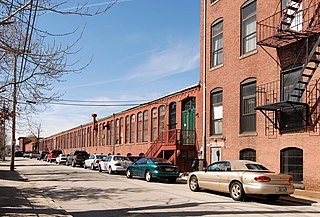
The Hope Webbing Company Mill is a historic textile mill at 999-1005 Main Street in Pawtucket, Rhode Island. The three brick buildings on this 7-acre (2.8 ha) are the surviving elements of what was once a larger complex, extending across Esten Avenue. The oldest portion of the main mill and the boiler house were built in 1889, with the mill growing by numerous additions through 1914. The preparing building was built in 1902 and enlarged in 1913. The Hope Webbing Company was established in 1883, and used these premises to manufacture narrow fabrics using many different types of fibers, including cotton, jute, wool, and silk. The company occupied all or part of the premises until 1994, when it moved its remaining production to Cumberland.
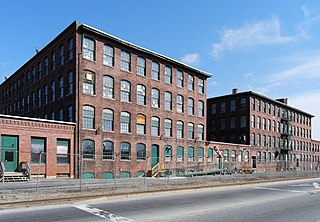
The Phillips Insulated Wire Company Complex is an historic industrial site at 413 Central Avenue in Pawtucket, Rhode Island. Encompassing three city blocks, the Phillips complex includes fourteen brick buildings with more than 350,000 square feet (33,000 m2) of space. They were built by the Phillips Insulated Wire Company between about 1898 and 1927. The company, established in 1888, was one of the most successful manufacturers of coated wire products, in an industry that ranked as the third-largest in Pawtucket. The complex was used by a variety of owners for the manufacture of such products until 2003.

The Potter–Collyer House is a historic house at 67 Cedar Street in Pawtucket, Rhode Island. The house, first constructed in 1863, is representative of vernacular architecture of the Pawtucket due to the great modifications to the home which has obscured the original structure of the home. Believed to have begun as a 1 1⁄2-story cottage with a gable roof, subsequent additions and expansions have added a two-story hip-roof addition and greatly altered the floor plan due to enlargement and remodeling. The Potter–Collyer House was added to the National Register of Historic Places in 1983.

St. Mary's Church of the Immaculate Conception Complex is an historic Roman Catholic church complex at 103 Pine Street in Pawtucket, Rhode Island.
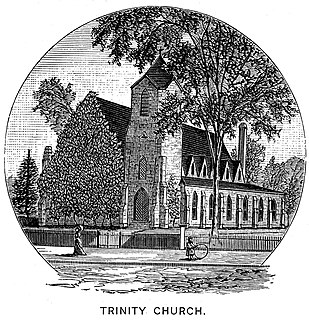
Trinity Episcopal Church was a historic church located at 48 Main Street in Pawtucket, Rhode Island. Built by the Episcopalians, the building was sold to the Catholics in 1977 and became the St. George Maronite Catholic Church within the Diocese of Providence. The church burned down in 2005, and was not rebuilt.

The Ashworth and Jones Factory is a historic building at 1511 Main Street in Worcester, Massachusetts. It is one of the architecturally finest mid 19th century factory buildings in the city. Built in 1870 and repeatedly enlarged, most of its sections retain high quality brickwork and mid-19th century Victorian styling. The factory was listed on the National Register of Historic Places in 1980. The complex has been converted into condominium residences known as Kettle Brook Lofts.
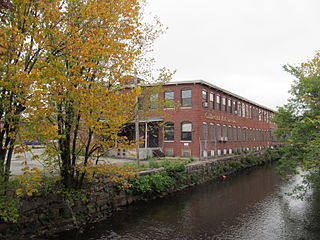
The Earnscliffe Woolen-Paragon Worsted Company Mill Complex is a historic mill at 25 and 39 Manton Avenue in Providence, Rhode Island. It consists of a grouping of eleven industrial buildings on 4.4 acres (1.8 ha) in the Olneyville neighborhood of Providence, on the banks of the Woonasquatucket River. The buildings were built between 1898 and about 1939. Building 1, the oldest building, began in 1898 as a two-story rectangular brick structure with a three-story tower and a monitor roof, but was expanded over the years, obscuring both the tower and the monitor. The complex was begun by the Earnscliff Woolen Company, which failed in 1909. The Paragon Worsted Company purchased the property, and operated on the premises until 1960, when the company closed the mill.

The New York Belting and Packing Co. complex, also known locally for its main 20th-century occupant, the Fabric Fire Hose Company, is a historic industrial complex at 45-71, 79-89 Glen Road in Newtown, Connecticut. Its centerpiece is a four-story brick mill building with an Italianate tower, built in 1856. The property also includes a dam impounding the adjacent Pootatuck River, a mill pond, and a hydroelectric power generation facility. The site's industrial history begins about 1850, when the dam was built. The New York Belting and Packing Company built the present factory building and another further upstream, where it operated until 1917. The property was then acquired by a subsidiary of Uniroyal, which let the premises to the Fabric Fire Hose Company, its tenant until 1977.
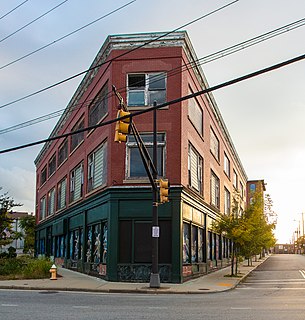
The Gately Building is a historic commercial building at 337–353 Main Street in downtown Pawtucket, Rhode Island The building was listed on the National Register of Historic Places in 2012. In 2015, the property was renovated into a 13-unit apartment building.

Blackstone River Valley National Historical Park is a National Park Service unit in the states of Rhode Island and Massachusetts. The park was created for the purpose of preserving, protecting, and interpreting the industrial heritage of the Blackstone River Valley and the urban, rural, and agricultural landscape of that region. The Blackstone River Valley was the site of some of the earliest successful textile mills in the United States, and these mills contributed significantly to the earliest American Industrial Revolution. The subsequent construction of the Blackstone Canal, a few years after the successful completion of the Erie Canal, helped to sustain the region's industrial strength.
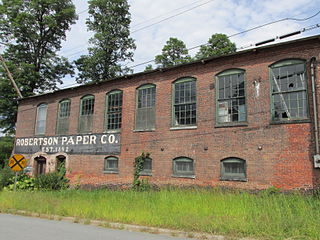
The Robertson Paper Company Complex was a historic industrial facility on Island Street in Bellows Falls, Vermont. It consisted of a collection of mostly-interconnected factory and related buildings, built between c. 1890 and c. 1960 by various paper-related companies. It was occupied and enlarged by the Robertson Paper Company between 1907 and its failure in 1987, at which time it was the longest-lived paper company in the state. The complex was listed on the National Register of Historic Places in 1990. It was demolished in 2018-19 as a Brownfields Economic Revitalization Alliance (BERA) project, with federal, state, and local funding.

The Andrews Mill Company Plant is a historic industrial complex at 761 Great Road in North Smithfield, Rhode Island. Built beginning in 1918, it was home to a maker of French worsted wool textiles, part of a major industrial development push in northern Rhode Island at the time. The complex was listed on the National Register of Historic Places in 2018.

The Moore Fabric Company Plant is a historic industrial complex at 45-47 Washington Street in Pawtucket, Rhode Island. The complex consists of five buildings built between 1878 and 1954, primarily for the purpose of manufacturing textiles with elastic components, although the oldest structure was built as a school. The complex was listed on the National Register of Historic Places in 2019. Plans have been laid to convert the property to residential use.





















